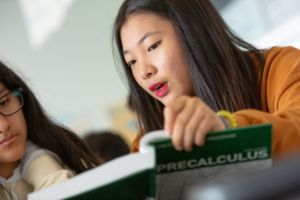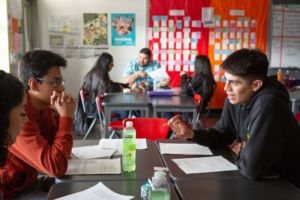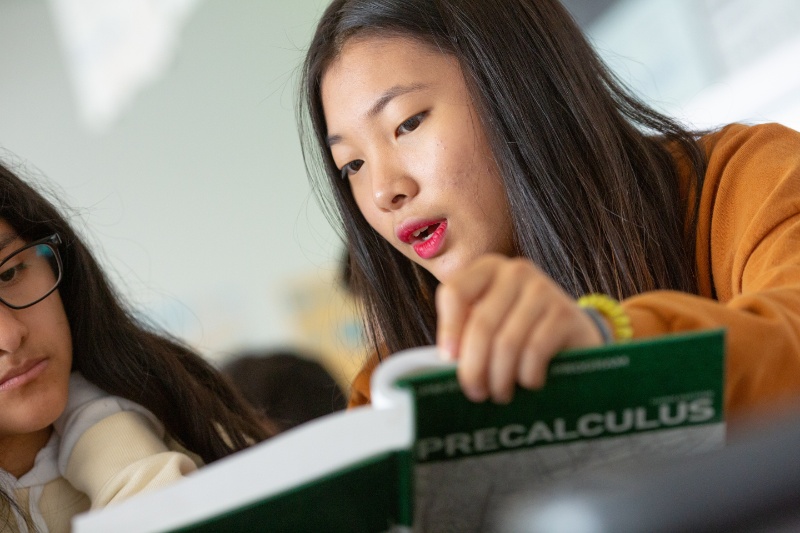If you have been teaching mathematics any time within the last seven or eight years, you have probably heard of NCTM’s (2014) Eight Effective Mathematics Teaching Practices. However, you may not have spent much time thinking or studying them as you may have seen it as just another thing to add to an already overwhelming full list of work to do. Some of you might already be following some of these practices without even knowing it, and for others, it might just be slight adjustments to your mathematical tasks, questioning, or dialogue that might bring some or all of these effective mathematics teaching practices to life. Below I share with you some ideas to shift secondary mathematics teaching to align more with NCTM’s Eight Effective Mathematics Teaching Practices.

1. Establish mathematics goals to focus learning.
Have you thought about what you want your students to be able to do at the end of the lesson? It is easy to get overwhelmed with the standards, but take some time to think about what exactly you want your students to be able to do and consider using student language and not the academic language of the standards. For instance, in teaching an Algebra II class about graphing rational functions, I want my students to be able to identify the end behavior, or horizontal, asymptotes of the rational functions. This learning goal guided me to provide my students with an end behavior investigation where they looked for patterns as the function is evaluated with larger and larger (and smaller and smaller) values.
2. Implement tasks that promote reasoning and problem solving.
In order for students to develop reasoning and problem solving skills, students need tasks where these skills can be practiced. Think open-ended tasks allowing students to use a variety of means to solve a problem. For instance, I asked my students to figure out how tall the tallest tree in a group of trees was (or how tall the high school building was) during a unit on right triangle trigonometry. The mathematics goal was for students to be able to apply right triangle trigonometry to find the height of real world objects. I presented my students with the task and a clinometer made out of a straw (or paper towel roll), a protractor, and a string with a washer on it. One group used their knowledge of a 45-45-90 special right triangle, while another group used the 30-60-90 special right triangle, and others used triangles with all sorts of angles and the tangent function to find the height. Additionally some measured using what they considered a yard, some walked toe-to-toe and measured the length of the shoe using the ruler on the protractor, while another group pulled out their cell phone and used a measuring app. In the end, all of the groups found the tallest tree and arrived at a similar answer.
3. Use and connect mathematical representations.
“What does it mean that I factored this equation and arrived at two answers or maybe the same one answer?” Or “why did I arrive at no real solution when using the quadratic formula to solve a quadratic equation?” These are questions students ask. When answering these questions, consider adding a sketch of the graph to your answer to help students see the connection to what they are solving algebraically. Add multiple representations, especially visuals, whenever possible to help students see the connections.
4. Facilitate meaningful mathematical discourse.
A recent idea I observed to increase meaningful mathematical discourse is to have your students find a partner and one person becomes the speaker and the other the transcriber. Pose a question to your students (e.g., solve an equation, graph a function, create a function rule) and have the speaker talk through how to answer the question while the transcriber writes down exactly what is being said. Then switch. When students are talking about the mathematics they are doing, not only is their mathematical discourse meaningful, but also they are building a stronger understanding.
Take some time to think about what exactly you want your students to be able to do.
5. Pose purposeful questions.
Ask questions that elicit reasoning and sense making. Questions can facilitate learning when students have the opportunity for discovery. Instead of starting a lesson on arithmetic sequences by providing students with the formula, provide them with time to make sense of the patterns in several arithmetic sequences and to develop their own rules, where some students will likely arrive at the formula. In using questions to assess students’ understanding, consider asking them to graph a function and describe what they notice. You might find a student who notices that the smallest possible value of x is 3, but does not make the connection with that being the domain. Now you know they need clarification on how that noticing describes the domain of the function. Additionally, you can reverse the questions you ask. Consider asking students to create a square root function that satisfies the following condition: Domain [3, ). Think about giving them the answer and having them come up with the question.

6. Build procedural fluency from conceptual understanding.
Do you start with the procedure of completing a task? If so, consider doing the opposite: start with a concept as the foundation for the procedures. For example, to introduce special right triangles to students with something they already know: an equilateral triangle and a square. The 30-60-90 triangle is created through an angle bisector in an equilateral triangle with a side length of one unit. The 45-45-90 triangle is created by dividing a square in half diagonally with a diagonal of one unit. Through this introduction no memorization is needed, and the perfect right triangles are no longer so magical.
7. Support productive struggle in learning mathematics.
Allowing your students to work through a productive struggle can be a challenging feat as our students are so good at reeling us in and getting us to tell them what they want to know. When your students are working on a task (such as finding the patterns in arithmetic sequences and creating their own rule) that you know they may struggle with and you want them to struggle with, be ready to let them struggle. “How?” you ask. Move quickly from group to group. Do not linger! The longer you stay with a group the more they will likely get out of you and less productive struggle will occur. Answer their questions with a question or pose a new idea for them to consider to keep the group moving forward. But, I repeat, do not linger!
8. Elicit and use evidence of student thinking.
Allow students to share their thinking through small and whole group discussions and through their writing. Invite students to share their work on the board. Invite students to share their methods of solving tasks or how they would interpret an answer and even have students reiterate what their classmates are saying. Not only does this provide a quick assessment of what your students know, but it allows students to make connections with their peers and for misconceptions to be seen and addressed.
When students are talking about the mathematics they are doing, not only is their mathematical discourse meaningful, but also they are building a stronger understanding.
I hope you are able to see how some things you are doing in your classroom already align with these teaching practices or how making slight shifts in your mathematics instruction could make it even more effective for your students. Be sure to share your ideas and celebrations with us on Twitter with @KeepINLearning.
Resources
Please login or register to claim PGPs.
Alternatively, you may use the PGP Request Form if you prefer to not register an account.



